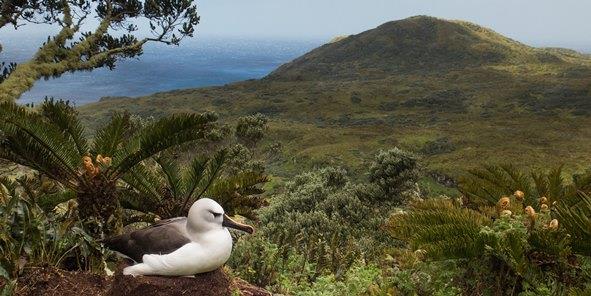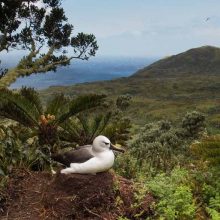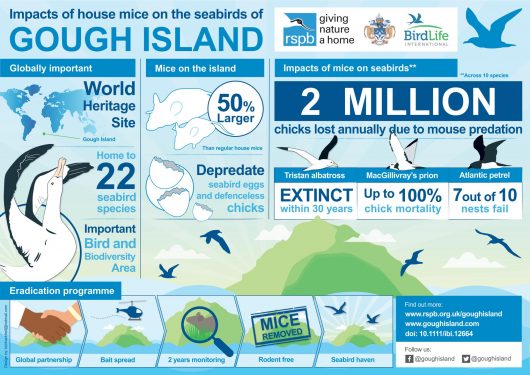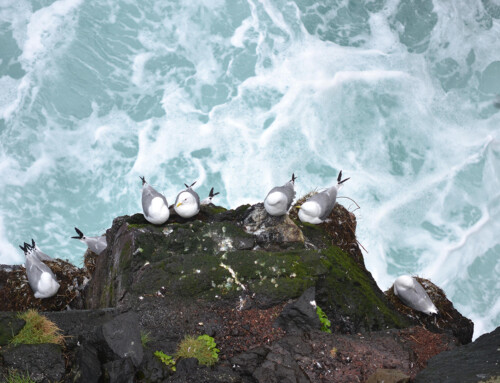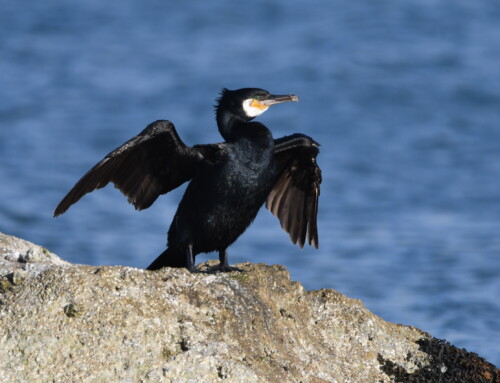Invasive mice kill nearly 2 million birds a year on Gough Island
LINKED PAPER
The impacts of introduced House Mice on the breeding success of nesting seabirds on Gough Island. Caravaggi, A., Cuthbert, R.J., Ryan, P.G., Cooper, J. & Bond, A.L. 2018. IBIS. DOI: 10.1111/ibi.12664. VIEW
For millions of seabirds far away in the South Atlantic Ocean, on a small island few people have even heard of, the night is a dangerous time, especially for chicks. In the pitch black, mice twice the size of those on the mainland wreak havoc, literally eating the birds alive.
Mice were introduced to Gough Island inadvertently in the 19th century, and have since spread across the entirety of one of the world’s most important seabird breeding colonies, home to 22 species, and two endemic landbirds. But only in the last 20 years have the effects of this invasion become apparent. Some years, working on Gough Island is like working in an ornithological trauma centre, with some species failing to raise a single chick.
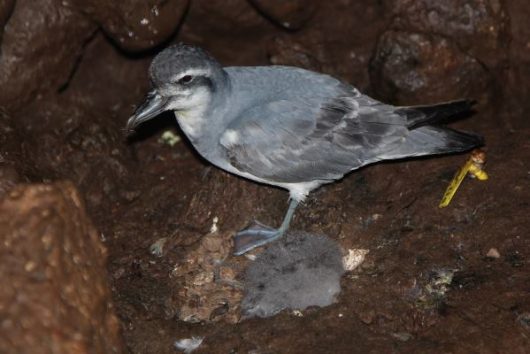
© J Cleeland
Seeing this devastation first-hand is heart-wrenching. More so because there is a solution. Invasive rodents have been removed successfully from >700 islands worldwide to the benefit of countless native species. And once those rodents are gone, the islands and the breeding colonies of seabirds that call them home, return to their former glories fairly quickly.
But Gough Island is more challenging. It’s far away, often shrouded in fog and battered by gales, with complex terrain and very high stakes. When planning the mouse eradication, the RSPB, Tristan da Cunha Government and their partners were often asked “OK, the pictures are grim, but how bad is it?”
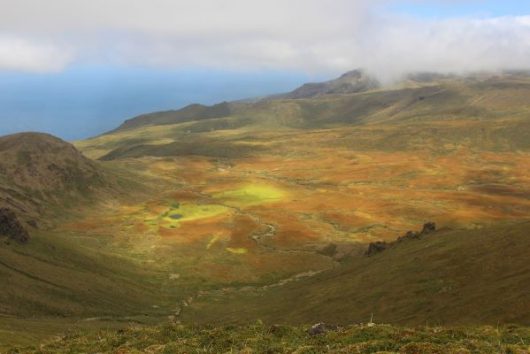
So we set out to put a number on what seemed immeasurable. How many seabird chicks were depredated by mice each year? Over more than 30 years, the RSPB, and the Percy FitzPatrick Institute at the University of Cape Town have collected information on breeding success (the number of chicks fledged per breeding pair) on about half the species breeding on Gough. More species would have been studied but even finding nests of the smaller storm-petrels and diving petrels is nearly impossible, let alone figuring out how many chicks they raise!
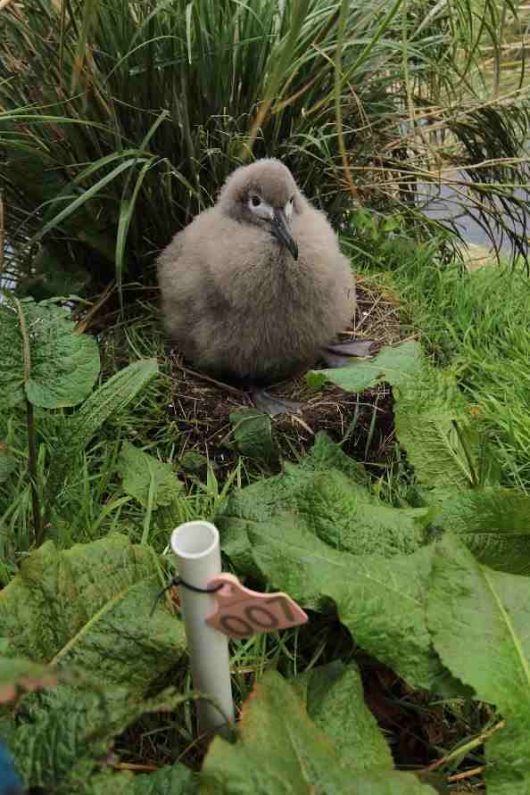
Breeding success is often influenced by things like body size, phylogeny, breeding habitat, and timing of breeding, so for each of the species on Gough, we found an analogue – a closely-related species of similar size that bred at about the same time of year, but on an island without any introduced predators. We could then compare the breeding success we measured on Gough, incorporating all the annual variation from the time series, to that of the predator-free analogues, and estimate the difference between them. Scaling up this difference to the estimated breeding population of each species on Gough gave us the sobering numbers.
Some species, like Southern Giant Petrels Macronectes giganteus, aren’t affected that much. Others, like MacGillivray’s Prions Pachyptila macgillivrayi, Atlantic Petrels Pterodroma incerta, and the iconic Tristan Albatross Diomedea dabbenena are in great peril. Each year, 1.7 million seabird chicks (95% confidence interval: 1.5-2.1 million chicks) are killed by mice on Gough Island. This is above and beyond the factors that otherwise influence breeding success like parental experience, food supplies, predation, and weather. And this only represents the mortality in about half the breeding species. For the other half, we don’t have enough, if any, data on breeding success; most are small burrow-nesting species that are heavily impacted by introduced rodents elsewhere, so the true number of chicks needlessly lost each year is probably much higher.
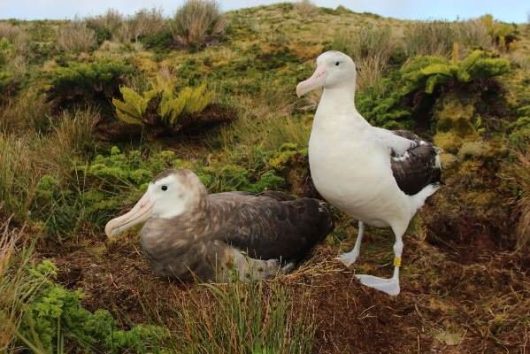
Thankfully there is a solution. The RSPB and Tristan da Cunha Government are leading the operation to rid Gough Island of mice once and for all, with the operation planned for the southern winter of 2020. This vital operation will secure the future of iconic, Critically Endangered species, like the Tristan Albatross and Gough Bunting Rowettia goughensis, as well as the other breeding bird species on the island.
CLICK HERE for larger version. Infographic designed by Kim Haddrell (kimhaddrell@hotmail.com).
Further reading
RSPB. Saving species from extinction: The Gough Island Restoration Programme. Available at: https://www.goughisland.com/ VIEW
RSPB. Gough Island Restoration Programme. Available at: https://www.rspb.org.uk/our-work/conservation/projects/gough-island-restoration-programme/ VIEW
Harper, M. 2018. Gough Island Restoration Programme. Martin Harper’s Blog. Available at: https://ww2.rspb.org.uk/community/ourwork/b/martinharper/archive/2018/10/16/gough-mouse-project.aspx VIEW
Image credits
Featured image: Atlantic Yellow-nosed Albatross Thalassarche chlororhynchos © Derren Fox
Blog posts express the views of the individual author(s) and not those of the BOU.
If you want to write about your research in #theBOUblog, then please see here.



